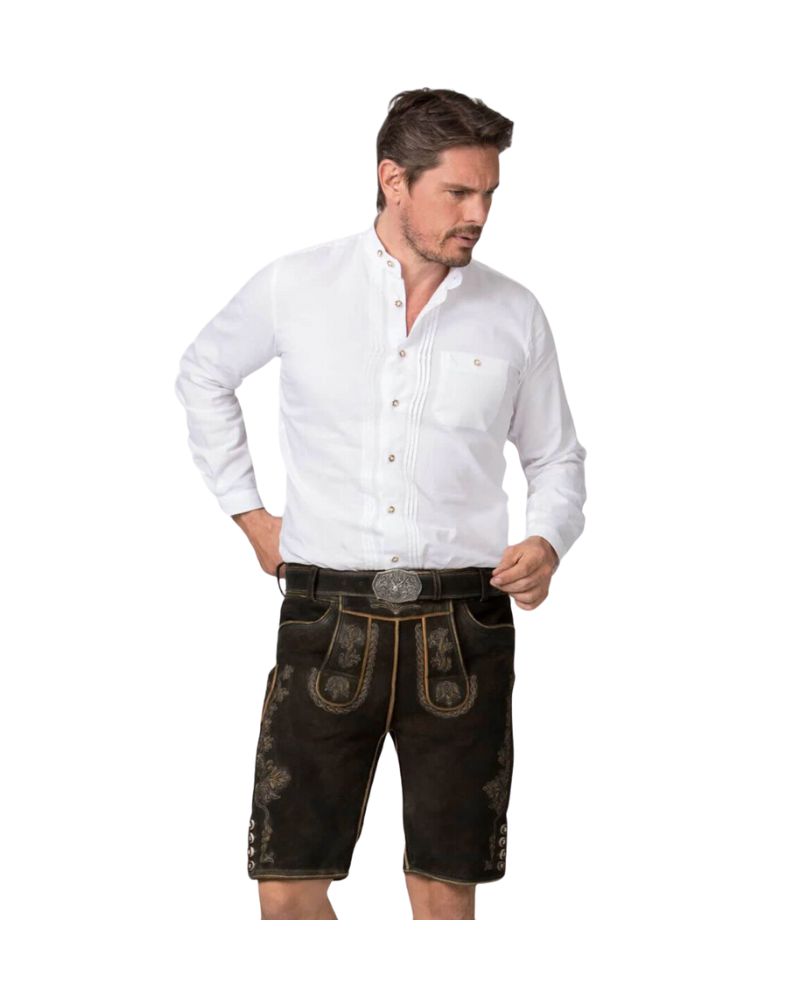History of Lederhosen: From Workwear to Bavarian Icon
1. Introduction to Lederhosen’s Cultural Significance
Lederhosen, the sturdy leather trousers synonymous with Bavarian tradition, are far more than a festive costume. These iconic garments carry centuries of history rooted deeply in Alpine culture. Initially designed for practical use, Lederhosen have evolved into a cultural symbol of pride and heritage in southern Germany and Austria. Their durability, versatility, and symbolic value make them a fascinating piece of traditional menswear.
2. Origin of Lederhosen in Alpine Workwear
The early roots of Lederhosen can be traced back to rural Alpine communities, where the garments were worn by peasants and hunters. Made from tanned leather, they were highly resistant to wear and tear—ideal for rugged terrains and manual labor. Unlike cloth trousers, Lederhosen offered unmatched longevity, even in harsh weather conditions. Their functionality was key to their widespread use during the 18th and 19th centuries.
3. Why Leather Was the Ideal Material
Leather wasn’t just a stylistic choice—it was a necessity. Animal hides provided protection from sharp branches, rocks, and cold climates. It could be cleaned easily and wouldn’t tear like cotton or wool. Over time, craftsmen developed various styles of Lederhosen using goat, deer, or cowhide. These materials also allowed intricate embroidery, which gradually introduced decorative elements to these utilitarian trousers.
4. Evolution into a Fashion Statement
As Bavarian society evolved, so did Lederhosen. By the late 19th century, the trousers began to carry more cultural and aesthetic value. People began wearing them not just for work, but during folk events and hunting trips. Embroideries representing regions, family crests, or Alpine motifs became common. The garment had made its first transition—from necessity to identity.
5. Lederhosen in Royal and Noble Circles
Surprisingly, Lederhosen even caught the attention of Bavarian nobility. King Ludwig II, known for his eccentric tastes, reportedly supported regional traditions, including the wearing of traditional outfits. In the 1880s, Prince Regent Luitpold popularized traditional Bavarian attire, including Lederhosen, during official events. This endorsement gave the garment a boost in respectability and solidified its position in Bavarian culture.
6. Role of Trachtenvereine (Traditional Costume Societies)
The formation of Trachtenvereine in the late 1800s helped preserve and promote Lederhosen as an essential element of local identity. These societies organized festivals and parades where men proudly showcased their Lederhosen. They also contributed to standardizing styles, patterns, and regional variations. The movement helped transition Lederhosen into ceremonial wear without losing its rustic charm.
7. Lederhosen and Oktoberfest: A Timeless Pair
Today, Lederhosen are inseparable from Oktoberfest celebrations. Each year, millions don these leather trousers to celebrate Bavarian heritage. The global popularity of Oktoberfest has elevated Lederhosen to international fame. Whether it’s locals embracing their roots or tourists indulging in German culture, the outfit remains a staple at every beer tent and folk fest.
To explore more on how a well-fitted pair of Lederhosen should look and feel during such events, you can check out this detailed guide on traditional fit.
8. The Symbolic Embroidery and Regional Touches
Each pair of Lederhosen often carries symbols or motifs unique to the region it comes from. For example, the Oberbayern style may have floral embroidery, while Allgäu may showcase deer or edelweiss. These details allow wearers to showcase their roots proudly. Over time, these decorations evolved from personal preferences into region-specific identifiers.
9. Contemporary Designs and Global Influence
Modern designers have taken Lederhosen to new heights. While traditional designs remain popular, contemporary versions include slim fits, unique colors, and even women’s versions. Brands now offer leather shorts that fuse urban fashion with Bavarian aesthetics. These adaptations make Lederhosen wearable at both local fests and international stages.
For a more modern and bold take, the Bamberg Nachtfall edition is a fine example. Its stylish design captures tradition and rebellion. View it here: classic meets modern.
10. Why Lederhosen Endure Through Generations
Unlike many fashion trends, Lederhosen have stood the test of time. Their symbolic value, combined with craftsmanship, makes them heirlooms passed through generations. In many families, young boys receive their first pair early on, and these are treasured throughout life. Wearing Lederhosen becomes a rite of passage and a source of cultural pride.
11. Sustainable Fashion: Lederhosen’s Hidden Advantage
In today’s fast-fashion world, Lederhosen offer a sustainable alternative. A single pair can last decades, reducing the need for frequent replacements. The leather used, often sourced ethically, contributes to the eco-friendly narrative. Investing in Lederhosen supports artisans and promotes conscious consumption.
12. How to Wear Lederhosen Today
Pairing Lederhosen with a checkered shirt and Haferlschuhe remains a classic look. For formal occasions, add a wool jacket or embroidered vest. Accessories like Alpine hats or traditional socks complete the look. Whether you’re heading to a wedding or a Volksfest, Lederhosen remain versatile and timeless.
13. Preserving the Tradition for Future Generations
Educational programs and cultural workshops are increasingly focused on keeping the tradition alive. Schools and folk communities encourage youth to participate in traditional dance and music—often requiring Lederhosen as part of the attire. This ensures the younger generation embraces their roots while adapting them to modern life.
14. Common Misconceptions About Lederhosen
Some believe Lederhosen are only worn during Oktoberfest, but they hold year-round significance in southern Germany. Others think they’re uncomfortable—but with the right fit, they’re surprisingly wearable. Another myth is that only older generations wear them, when in fact, young Bavarians often flaunt them with pride.
15. Conclusion: More Than Just Leather Pants
From rugged mountain paths to Oktoberfest dance floors, Lederhosen have traveled a long way. What began as simple workwear is now a beloved symbol of cultural identity. Whether you’re wearing them to honor tradition or make a statement, Lederhosen continue to connect the past with the present.
To discover authentic styles and traditional craftsmanship, visit this dedicated collection of men’s Lederhosen.
FAQs About Lederhosen
1. Are Lederhosen still worn outside Oktoberfest?
Yes, especially in Bavaria and Austria, people wear them during weddings, festivals, and folk events year-round.
2. What is the best leather type for Lederhosen?
Deerskin is the most luxurious and softest, but cowhide and goatskin are also commonly used for durability.
3. How long do traditional Lederhosen last?
With proper care, a quality pair can last for decades and even be passed down through generations.
4. Do women wear Lederhosen?
Yes, women’s Lederhosen are a popular modern twist and often styled with feminine blouses or crop tops.
5. Can I wash Lederhosen in a machine?
No, it’s best to clean them using a damp cloth and specialized leather cleaners to maintain the material.
6. Are there different types of Lederhosen?
Yes, from short (kurze) to knee-length (kniebund) versions, each style suits different occasions and regions.
for more detail


